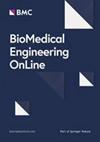In vivo video microscopy of the rupturing process of thin blood vessels to clarify the mechanism of bruising caused by blunt impact: an animal study
IF 2.9
4区 医学
Q3 ENGINEERING, BIOMEDICAL
引用次数: 0
Abstract
The thresholds of mechanical inputs for bruising caused by blunt impact are important in the fields of machine safety and forensics. However, reliable data on these thresholds remain inadequate owing to a lack of in vivo experiments, which are crucial for investigating the occurrence of bruising. Since experiments involving live human participants are limited owing to ethical concerns, finite-element method (FEM) simulations of the bruising mechanism should be used to compensate for the lack of experimental data by estimating the thresholds under various conditions, which requires clarifying the mechanism of formation of actual bruises. Therefore, this study aimed to visualize the mechanism underlying the formation of bruises caused by blunt impact to enable FEM simulations to estimate the thresholds of mechanical inputs for bruising. In vivo microscopy of a transparent glass catfish subjected to blunt contact with an indenter was performed. The fish were anesthetized by immersing them in buffered MS-222 (75–100 mg/L) and then fixed on a subject tray. The indenter, made of transparent acrylic and having a rectangular contact area with dimensions of 1.0 mm × 1.5 mm, was loaded onto the lateral side of the caudal region of the fish. Blood vessels and surrounding tissues were examined through the transparent indenter using a microscope equipped with a video camera. The contact force was measured using a force-sensing table. One of the processes of rupturing thin blood vessels, which are an essential component of the bruising mechanism, was observed and recorded as a movie. The soft tissue surrounding the thin blood vessel extended in a plane perpendicular to the compressive contact force. Subsequently, the thin blood vessel was pulled into a straight configuration. Next, it was stretched in the axial direction and finally ruptured. The results obtained indicate that the extension of the surrounding tissue in the direction perpendicular to the contact force as well as the extension of the thin blood vessels are important factors in the bruising mechanism, which must be reproduced by FEM simulation to estimate the thresholds.活体视频显微镜观察细血管破裂过程,阐明钝器撞击造成瘀伤的机制:一项动物研究
钝器撞击造成瘀伤的机械输入阈值在机器安全和法医学领域非常重要。然而,由于缺乏活体实验,有关这些阈值的可靠数据仍然不足,而活体实验对于研究瘀伤的发生至关重要。出于伦理考虑,涉及活人的实验有限,因此应采用有限元法(FEM)模拟瘀伤机制,通过估算各种条件下的阈值来弥补实验数据的不足,这就需要明确实际瘀伤的形成机制。因此,本研究旨在将钝器撞击导致的瘀伤形成机制可视化,以便通过有限元模拟估算瘀伤的机械输入阈值。研究人员对受到压头钝性接触的透明玻璃鲶鱼进行了活体显微镜观察。将鱼浸入缓冲液 MS-222(75-100 毫克/升)中进行麻醉,然后固定在受试者托盘上。压头由透明丙烯酸制成,接触面积为 1.0 mm × 1.5 mm 的矩形,压头装在鱼体尾部的外侧。使用配备摄像机的显微镜通过透明压头检查血管和周围组织。接触力是通过力感应台测量的。观察并记录了薄血管破裂的其中一个过程,这也是瘀伤机制的重要组成部分。细血管周围的软组织在垂直于压缩接触力的平面上延伸。随后,细血管被拉成一条直线。接着,它在轴向被拉伸,最后破裂。所得结果表明,周围组织在垂直于接触力方向上的延伸以及细血管的延伸是淤血机制中的重要因素,必须通过有限元模拟再现这些因素,以估计阈值。
本文章由计算机程序翻译,如有差异,请以英文原文为准。
求助全文
约1分钟内获得全文
求助全文
来源期刊

BioMedical Engineering OnLine
工程技术-工程:生物医学
CiteScore
6.70
自引率
2.60%
发文量
79
审稿时长
1 months
期刊介绍:
BioMedical Engineering OnLine is an open access, peer-reviewed journal that is dedicated to publishing research in all areas of biomedical engineering.
BioMedical Engineering OnLine is aimed at readers and authors throughout the world, with an interest in using tools of the physical and data sciences and techniques in engineering to understand and solve problems in the biological and medical sciences. Topical areas include, but are not limited to:
Bioinformatics-
Bioinstrumentation-
Biomechanics-
Biomedical Devices & Instrumentation-
Biomedical Signal Processing-
Healthcare Information Systems-
Human Dynamics-
Neural Engineering-
Rehabilitation Engineering-
Biomaterials-
Biomedical Imaging & Image Processing-
BioMEMS and On-Chip Devices-
Bio-Micro/Nano Technologies-
Biomolecular Engineering-
Biosensors-
Cardiovascular Systems Engineering-
Cellular Engineering-
Clinical Engineering-
Computational Biology-
Drug Delivery Technologies-
Modeling Methodologies-
Nanomaterials and Nanotechnology in Biomedicine-
Respiratory Systems Engineering-
Robotics in Medicine-
Systems and Synthetic Biology-
Systems Biology-
Telemedicine/Smartphone Applications in Medicine-
Therapeutic Systems, Devices and Technologies-
Tissue Engineering
 求助内容:
求助内容: 应助结果提醒方式:
应助结果提醒方式:


